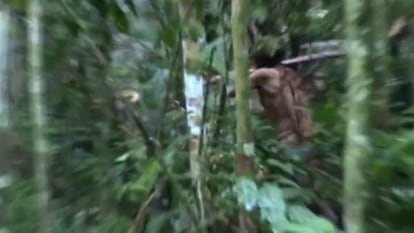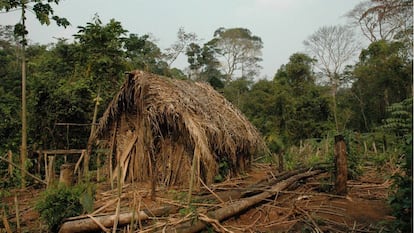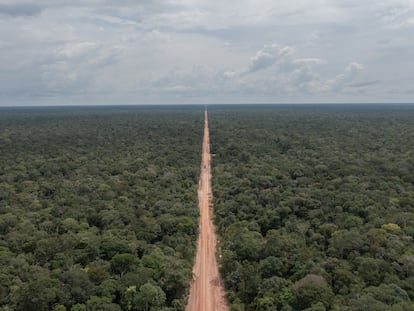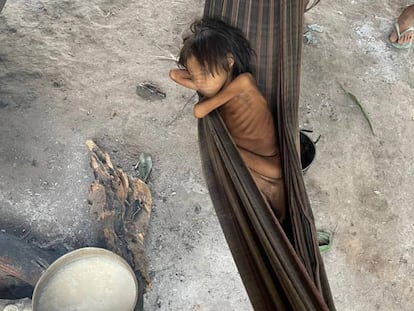The last of his tribe: Brazil’s most solitary man dies
The “Man of the Hole” was found dead earlier this month. He was the only remaining member of an isolated indigenous community that was massacred in 1995


Brazil’s loneliest indigenous man, the only survivor of a slaughtered tribe, chose to live out his life alone. In late August, he was found dead in his hammock, covered with macaw feathers. Known as the “Man of the Hole” (indio do buraco, in Portuguese) because he dug deep pits inside his huts, he lived on Tanaru tribal land, in the state of Rondônia (western Brazil). His partially decomposed body was discovered by Altair Algayer, a Brazilian government official who had monitored the solitary man for the last 26 years. He was the last of a tribe of unknown ethnicity who never communicated with other groups. Brazilian officials believe he died of natural causes.
Ironically, he was well-known in Brazil precisely because he lived in solitude for so many years. Brazil’s National Indian Foundation (Fundação Nacional do Índio - FUNAI), the government agency responsible for protecting the country’s indigenous peoples, transferred his remains to the capital, Brasilia, for forensic analysis. The Man of the Hole lived on 50 square miles (80 square kilometers) of land surrounded by cattle ranches, protected by a specific law that barred outsiders from intruding. He is believed to have been about 60 years old. Brazilian authorities intend to bury him on the land where he lived out his life.
For the past 26 years, Algayer led a FUNAI team that watched over the man from afar, maintaining the long-time Brazilian policy of no contact with indigenous peoples who choose to shun the outside world. Once every three months, a FUNAI team would approach and set up cameras to monitor his activity and see if anyone had invaded his protected land. That’s how they know that he died in the 53rd hut he had built since the monitoring began. All of his huts “had the same design, and always with a pit inside,” said the FUNAI notice of his death.

Waiting for death
In an interview with Amazonia Real, Marcelo dos Santos, one of the FUNAI team members who monitored the Man of the Hole, said, “He was found in his hammock, covered with macaw feathers. He was waiting for death — there were no signs of violence.”
Not many images of the anonymous man exist. The clearest ones are from a video released a few years ago. Almost completely naked, the man is chopping down a tree unaware that he is being filmed from a distance. He never spoke with his protectors, perhaps to avoid being identified by his native language, but he did accept some seeds and tools that were left for him to find. Brazil’s Organization for Isolated Peoples said that these items were left behind “to improve his quality of life.”
Brazil’s uncontacted peoples are the most vulnerable of the country’s 115 indigenous tribes, yet they are the most adept at jungle and biodiversity conservation. The Javari valley, on Brazil’s border with Colombia and Peru, is where most of these tribes are located. Last June, Bruno Pereira, an expert in uncontacted peoples, and British journalist Dom Philips were murdered by poachers in the Javari Valley. The Brazilian institutions responsible for protecting the environment, indigenous peoples and biodiversity have become significantly weaker since President Jair Bolsonaro was elected almost four years ago.
The Man of the Hole is the only known survivor of a 1995 massacre, when some large landowners greedy for more land paid local settlers to exterminate the entire tribe and destroy all traces of their existence. He began a new life of almost complete solitude, living on wild boars, turtles and birds that he hunted or trapped. The Man of the Hole also liked honey.
The Organization for Isolated Peoples said that the Man of the Hole “was the victim of an atrocious process of extermination caused by government-sanctioned incursions by large ranches. He saw his people die out and his land turned into pasture. He was condemned to spend the rest of his life in a small area of protected forest surrounded by the large ranches that dominate the Corumbiara River area in Rondônia.” Now that the Man of the Hole is gone, people fear that his little patch of land will soon be at the mercy of big agricultural interests.
Tu suscripción se está usando en otro dispositivo
¿Quieres añadir otro usuario a tu suscripción?
Si continúas leyendo en este dispositivo, no se podrá leer en el otro.
FlechaTu suscripción se está usando en otro dispositivo y solo puedes acceder a EL PAÍS desde un dispositivo a la vez.
Si quieres compartir tu cuenta, cambia tu suscripción a la modalidad Premium, así podrás añadir otro usuario. Cada uno accederá con su propia cuenta de email, lo que os permitirá personalizar vuestra experiencia en EL PAÍS.
¿Tienes una suscripción de empresa? Accede aquí para contratar más cuentas.
En el caso de no saber quién está usando tu cuenta, te recomendamos cambiar tu contraseña aquí.
Si decides continuar compartiendo tu cuenta, este mensaje se mostrará en tu dispositivo y en el de la otra persona que está usando tu cuenta de forma indefinida, afectando a tu experiencia de lectura. Puedes consultar aquí los términos y condiciones de la suscripción digital.
More information

Journey down BR-319: The path towards the destruction of the Amazon rainforest
Últimas noticias
Most viewed
- Sinaloa Cartel war is taking its toll on Los Chapitos
- Oona Chaplin: ‘I told James Cameron that I was living in a treehouse and starting a permaculture project with a friend’
- Reinhard Genzel, Nobel laureate in physics: ‘One-minute videos will never give you the truth’
- Why the price of coffee has skyrocketed: from Brazilian plantations to specialty coffee houses
- Silver prices are going crazy: This is what’s fueling the rally










































